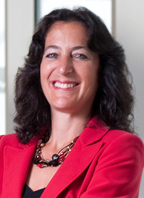Joint Colloquium Distinguished Lecture Series
The Road Ahead for Wireless Technology: Dreams and Challenges
 |
Wednesday, October 10, 2012 Andrea Goldsmith |
Abstract:
Wireless technology has enormous potential to change the way we live, work, and play. Future wireless networks will support Gigabit per second multimedia communication between people and devices with high reliability and uniform coverage indoors and out. Software will create a virtual wireless network cloud, enabling resource management, seamless connectivity, and roaming across heterogeneous access networks, including WiFi and cellular systems. Wireless technology will also enable smart and energy-efficient homes and buildings, automated highways and skyways, and in-body networks for analysis and treatment of medical conditions. The shortage of spectrum will be alleviated by advances in cognitive radios, and breakthrough energy-efficiency algorithms and hardware will be employed to make wireless systems “green”. There are many technical challenges that must be overcome in order to make this vision a reality. This talk will describe what the wireless future might look like and some of the innovations and breakthroughs that are required to realize this vision.
Biography
Andrea Goldsmith is a professor of Electrical Engineering at Stanford University, and was previously an assistant professor of Electrical Engineering at Caltech. While on leave from Stanford, she founded and served as CTO of Quantenna Communications Inc., a semiconductor company developing nextgeneration wireless network technology. She also previously held industry positions at Maxim Technologies, Memorylink Corporation and AT&T Bell Laboratories. Her research includes work on design and capacity analysis of wireless systems and networks, cognitive radios, sensor and “green” networks, cross‐layer wireless network design, and applications of communications and signal processing to health and neuroscience. She is author of the book ``Wireless Communications'' and co‐author of the book ``MIMO Wireless Communications,'' both published by Cambridge University Press. She received the B.S., M.S. and Ph.D. degrees in Electrical Engineering from U.C. Berkeley.
| Return to EECS Joint Colloquium |

